 W
WA subculture is a group of people within a culture that differentiates itself from the parent culture to which it belongs, often maintaining some of its founding principles. Subcultures develop their own norms and values regarding cultural, political, and sexual matters. Subcultures are part of society while keeping their specific characteristics intact. Examples of subcultures include hippies, goths, bikers, and skinheads. The concept of subcultures was developed in sociology and cultural studies. Subcultures differ from countercultures.
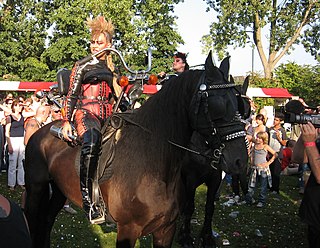 W
WAlternative culture is a type of culture that exists outside or on the fringes of mainstream or popular culture, usually under the domain of one or more subcultures. Camden Town is known for its alternative culture. These subcultures may have little or nothing in common besides their relative obscurity, but cultural studies uses this common basis of obscurity to classify them as alternative cultures, or, taken as a whole, the alternative culture. Compare with the more politically charged term, counterculture.
 W
WAlternative modeling is a branch of the modeling industry that features models who do not conform to mainstream ideals of beauty. Alternative models are often niche-specific, with a personal style that represents subcultures like goth, steampunk, and fetishism. An alternative model may, for example, be tattooed, pierced, or have other body modifications, have distinctively subcultural hair such as being shaved, dyed a distinctively unnatural color, or styled into a mohawk or dreadlocks. Alternative modeling can be clothed or unclothed.
 W
W"Big Beautiful Woman" is a euphemism for an overweight woman.
 W
WCannabis culture describes a social atmosphere or series of associated social behaviors that depends heavily upon cannabis consumption, particularly as an entheogen, recreational drug and medicine.
 W
WCowpunk is a subgenre of punk rock that began in the United Kingdom in the late 1970s and Southern California in the early 1980s. It combines punk rock or new wave with country, folk, and blues in its sound, lyrical subject matter, attitude, and style. Examples include Social Distortion, The Gun Club, The Long Ryders, Dash Rip Rock, Violent Femmes, The Blasters, Mojo Nixon, Meat Puppets, The Beat Farmers, Rubber Rodeo, Rank and File, and Jason and the Scorchers. Many of the musicians in this scene subsequently became associated with alternative country, roots rock or Americana.
 W
WThe Cultural Creatives: How 50 Million People Are Changing the World is a nonfiction social sciences and sociology book by sociologist Paul H. Ray and psychologist Sherry Ruth Anderson, The authors introduced the term "Cultural Creatives" to describe a large segment in Western society who since about 1985 have developed beyond the standard paradigm of modernists or progressives versus traditionalists or conservatives. Ray and Anderson claim to have found 50 million adult Americans can now be identified as belonging to this group. They estimated an additional 80–90 million "Cultural Creatives" exist in Europe as of 2000.
 W
WCyberdelic was the fusion of cyberculture and the psychedelic subculture that formed a new counterculture in the 1980s and 1990s.
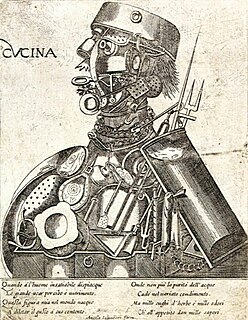 W
WCyborg art, also known as cyborgism, is an art movement that began in the mid-2000s in Britain. It is based on the creation and addition of new senses to the body via cybernetic implants and the creation of art works through new senses. Cyborg artworks are created by cyborg artists; artists whose senses have been voluntarily enhanced through cybernetic implants. Among the early artists shaping the cyborg art movement are Neil Harbisson, whose antenna implant allows him to perceive ultraviolet and infrared colours, and Moon Ribas whose implants in her feet allow her to feel earthquakes and moonquakes. Other cyborg artists include:Manel De Aguas, a Catalan photographer who developed fins that allow him to perceive atmospheric pressure, humidity and temperature through a couple of implants at each side of his head. Joe Dekni, an artist who has developed and installed a radar system in his head. The sensory system includes two implants in his cheekbones. Pau Prats, creator of a system that allows him to feel the ultraviolet ray levels that reach his skin. Alex Garcia, whose sensor installed in his chest allows him to feel the air quality levels around him. Kai Landre, a musician developing two implants to hear the sound of the particles affected by the collusion of cosmic rays.
 W
WDark academia is a social media aesthetic and subculture centered around higher education, writing/poetry, the arts, and classic Greek and Gothic architecture. The subculture is associated with ancient art and classic literature.
 W
WThe demoscene is an international computer art subculture focused on producing demos: self-contained, sometimes extremely small, computer programs that produce audiovisual presentations. The purpose of a demo is to show off programming, visual art, and musical skills. Demos and other demoscene productions are shared at festivals known as demoparties, voted on by those who attend and released online.
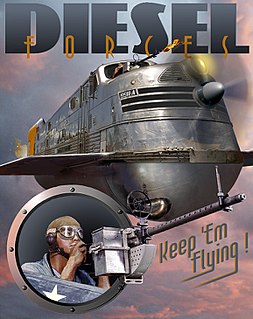 W
WDieselpunk is a retrofuturistic subgenre of science fiction similar to steampunk or cyberpunk that combines the aesthetics of the diesel-based technology of the interwar period through to the 1950s with retro-futuristic technology and postmodern sensibilities. Coined in 2001 by game designer Lewis Pollak to describe his tabletop role-playing game Children of the Sun, the term has since been applied to a variety of visual art, music, motion pictures, fiction, and engineering.
 W
WFitness culture is a sociocultural phenomenon surrounding exercise and physical fitness. It is usually associated with gym culture, as doing physical exercises in locations such as gyms, wellness centres and health clubs is a popular activity. An international survey found that more than 27% of world total adult population attends fitness centres, and that 61% of regular exercisers are currently doing "gym-type" activities.
 W
WFitness fashion is the result of a trend that consists in combining physical activities and health lifestyles with the interest and use of sportswear fashion.
 W
WThe furry fandom is a subculture interested in anthropomorphic animal characters with human personalities and characteristics. Examples of anthropomorphic attributes include exhibiting human intelligence and facial expressions, speaking, walking on two legs, and wearing clothes. The term "furry fandom" is also used to refer to the community of people who gather on the Internet and at furry conventions, or otherwise participate in the subculture. Individual members of the fandom are known as "furries".
 W
WG0y, gØy, g-zero-y is a subculture that appeared in the 2000s in the United States and has since spread to Brazil. The g0y self-identify as men who are attracted to men, but not as homosexual or bisexual. In such relationships, men consider hugging, kissing on lips, caressing, frotting, French kissing, mutual masturbation and fellatio as acceptable. They do not participate in anal sex, seeing it as gay or even violent and dangerous.
 W
WGreasers are a youth subculture that emerged in the 1950s and early 1960s from predominantly working class and lower class teenagers and young adults in the United States. The subculture remained prominent into the mid-1960s and was particularly embraced by certain ethnic groups in urban areas, particularly Italian Americans and Latino Americans.
 W
WThe Hanfu Movement, also known as the Hanfu Revival Movement, is a cultural movement seeking to revitalize Han Chinese fashion that developed in China since the beginning of the 21st century.
 W
WHi-risers, also known as donks and quan-cars, are a type of heavily-customized automobile, typically a full-size, body-on-frame, rear-wheel drive American sedan modified by significantly increasing the vehicle's ground clearance and adding large-diameter wheels with low-profile tires. Depending on the model and style of body, autos customized in this manner can be labeled," "box," or "bubble."
 W
WA hippie, also spelled as hippy, was a member of the counterculture of the 1960s, originally a youth movement that began in the United States during the mid-1960s and spread to other countries around the world. The word hippie came from hipster and was used to describe beatniks who moved into New York City's Greenwich Village, San Francisco's Haight-Ashbury district, and Chicago's Old Town community. The term hippie was used in print by San Francisco writer Michael Fallon, helping popularise use of the term in the media, although the tag was seen elsewhere earlier.
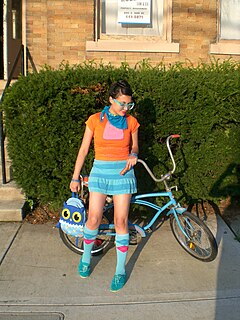 W
WThe 21st-century hipster is a subculture that is defined by claims to authenticity and uniqueness yet, ironically, is notably lacking in authenticity and conforms to a collective style. The subculture embodies a particular ethic of consumption that seeks to commodify the idea of rebellion or counterculture. Fashion is one of the major markers of hipster identity. Members of the subculture typically do not self-identify as hipsters, and the word hipster is often used as a pejorative for someone who is pretentious or overly concerned with appearing trendy or fashionable in a non-mainstream way.
 W
WIndie art, a shortened form of independent art is art produced by artists independent of the mainstream commercial fine arts market, which includes such institutions as art auctions, art dealers, and major art galleries. Galleries featuring indie art also exist.
 W
WInternet culture, or cyberculture, is a culture that describes the many manifestations of the use of computer networks for communication, entertainment, business, and recreation. Some features of Internet culture include online communities, gaming, social media, and more, as well as topics related to identity and privacy. Due to the internet’s large scale use and adoption, the impacts of internet culture on society and non-digital cultures have been widespread. Additionally, because of the all encompassing nature of the internet and internet culture, different facets of internet culture are often studied individually rather than holistically, such as social media, gaming, specific communities, and more.
 W
WLa Sape, an abbreviation based on the phrase Société des Ambianceurs et des Personnes Élégantes and hinting to the French slang word sape which means "clothes" or sapé, which means "dressed up", is a subculture centered on the cities of Kinshasa and Brazzaville in the Democratic Republic of the Congo and Republic of Congo respectively. An adherent of La Sape is known as a sapeur or, if female, as a sapeuse. The movement embodies the elegance in style and manners of colonial predecessor dandies.
 W
WA leisure suit is a casual suit consisting of a shirt-like jacket and matching trousers (pants) often associated with American-influenced fashion and fads of the 1970s.
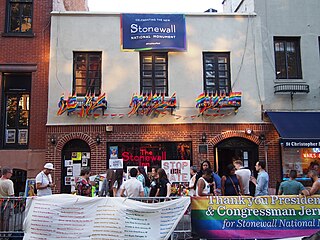 W
WLesbian, gay, bisexual, and transgender (LGBT) movements are social movements that advocate for LGBT people in society. Social movements may focus on equal rights, such as the ongoing movement for same-sex marriage, or they may focus on liberation, as in the gay liberation movement of the 1960s and 1970s. Earlier movements focused on self-help and self-acceptance, such as the homophile movement of the 1950s. Although there is not a primary or an overarching central organization that represents all LGBT people and their interests, numerous LGBT rights organizations are active worldwide. The earliest organizations to support LGBT rights were formed in the early 20th century.
 W
WA lowrider or low rider is a customized car with a lowered body. These customized vehicles are generally individually painted with intricate, colorful designs, rolling on wire-spoke wheels with whitewall tires. Lowrider rims are generally smaller than the original wheels, ranging down to 13 inches (330 mm). They are also fitted with hydraulic or air bag systems that allow height adjustable suspension, where the vehicle is raised or lowered at the owner's command. Given these specific characteristics, while a lowrider is always a lowered car, a lowered car is not always a lowrider. The term is used to describe a class of vehicle, not simply the height from ground to chassis.
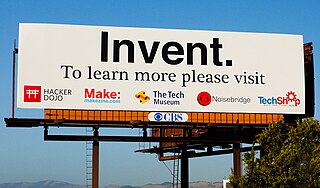 W
WThe maker culture is a contemporary subculture representing a technology-based extension of DIY culture that intersects with hardware-oriented parts of hacker culture and revels in the creation of new devices as well as tinkering with existing ones. The maker culture in general supports open-source hardware. Typical interests enjoyed by the maker culture include engineering-oriented pursuits such as electronics, robotics, 3-D printing, and the use of computer numeric control tools, as well as more traditional activities such as metalworking, woodworking, and, mainly, its predecessor, traditional arts and crafts.
 W
WMetrosexual is a portmanteau of metropolitan and sexual coined in 1994, describing a man of ambiguous sexuality, who is especially meticulous about his grooming and appearance, typically spending a significant amount of time and money on shopping as part of this.
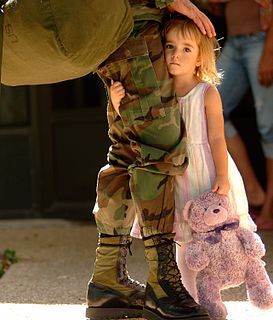 W
WIn the United States, a military brat is the child of a parent or parents serving full-time in the United States Armed Forces, whether current or former. The term military brat can also refer to the subculture and lifestyle of such families.
 W
WMy Little Pony: Friendship Is Magic is an animated television series produced by Hasbro as part of the My Little Pony toy franchise, which is tied in with the 2010 relaunch of dolls and play sets and original programming for the American children's cable channel Discovery Family. Lauren Faust was selected as the creative developer and executive producer for the show based on her previous animation experience with other animated shows such as Cartoon Network's The Powerpuff Girls and Foster's Home for Imaginary Friends. Under Hasbro's guidance, Faust developed the show to appeal to the target demographic of young girls, but created characters and settings that challenged formerly stereotypical norms of "girly" images and added adventure and humorous elements in order to keep parents interested.
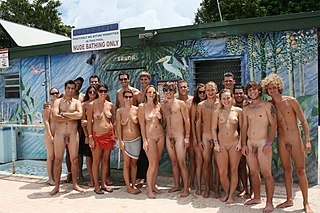 W
WNaturism is a lifestyle of non-sexual social nudity, and the cultural movement which advocates for and defends that lifestyle. Both may also be referred to as nudism. Though the two terms are largely interchangeable, nudism emphasizes the practice of nudity, whereas naturism highlights an attitude favoring harmony with nature and respect for the environment, into which that practice is integrated. That said, naturists come from a range of philosophical and cultural backgrounds; there is no single naturist ideology.
Nerdfighteria is a mainly online-based community subculture centred around interesting and attention-getting activities with the purpose of combating mediocracy and negativity, as well as decreasing "world suck". It originated on YouTube in 2007, when the VlogBrothers rose to prominence in the YouTube community. As their popularity grew, so did coverage on Nerdfighteria, whose followers are individually known as Nerdfighters. The term was coined when John saw a copy of the arcade game Aero Fighters and misread the title as Nerd Fighters.
 W
WNew Age is a range of spiritual or religious practices and beliefs which rapidly grew in the Western world during the 1970s. Precise scholarly definitions of the New Age differ in their emphasis, largely as a result of its highly eclectic structure. Although analytically often considered to be religious, those involved in it typically prefer the designation of spiritual or Mind, Body, Spirit and rarely use the term New Age themselves. Many scholars of the subject refer to it as the New Age movement, although others contest this term and suggest that it is better seen as a milieu or zeitgeist.
 W
WOtherkin are a subculture of people who identify as not entirely human. Some otherkin believe their identity derives from reincarnation, trans-species dysphoria of the soul, ancestry, or metaphor. Others attribute it to unusual psychology and do not hold spiritual beliefs on the subject. Categories of otherkin include Fictionkin, those who identify as fictional characters; Conceptkin, who identify as abstract concepts; Weatherkin, who identify as weather systems; as well as a number of other more obscure categories. Joseph P. Laycock, assistant professor of religious studies at Texas State University, considers otherkin beliefs to have a religious dimension, but asserts that "the argument that Otherkin identity claims conform to a substantive definition of religion is problematic". Many otherkin themselves reject the notion that being otherkin is a religious belief. It is often confused with clinical lycanthropy.
 W
WPachucos are male members of a counterculture associated with zoot suit fashion, jazz and swing music, a distinct dialect known as caló, and self-empowerment in rejecting assimilation into Anglo-American society that emerged in Los Angeles in the late 1930s. The pachuco counterculture flourished among Chicano boys and men in the 1940s as a symbol of rebellion, especially in Los Angeles. It spread to women who became known as pachucas and were perceived as unruly, masculine, and un-American. Some pachucos adopted strong attitudes of social defiance, engaging in behavior seen as deviant by white/Anglo-American society, such as marijuana smoking, gang activity, and a turbulent night life. Although concentrated among a relatively small group of Mexican Americans, the pachuco counterculture became iconic among Chicanos and a predecessor for the cholo subculture which emerged among Chicano youth in the 1980s.
 W
WParty and play (PnP), also called chemsex or wired play, is the consumption of drugs to facilitate or enhance sexual activity. Sociologically, it refers to a subculture of recreational drug users who engage in high-risk sexual activities under the influence of drugs within sub-groups. This can include unprotected sex during sessions with multiple sexual partners that may continue for days.
 W
WThe term "perpetual traveler" refers to the idea that by basing different aspects of one's life in different countries and not spending too long in any one place, a person can reduce taxes, avoid civic duties, and increase personal freedom. Books and services relating to the PT idea have been a staple of companies that specialise in marketing offshore financial services, tax avoidance schemes, and personal privacy services.
 W
WPsychedelia refers to the psychedelic subculture of the 1960s and the psychedelic experience. This includes psychedelic art, psychedelic music and style of dress during that era. This was primarily generated by people who used psychedelic drugs such as LSD, mescaline and psilocybin and also non-users who were participants and aficionados of this subculture. Psychedelic art and music typically recreate or reflect the experience of altered consciousness. Psychedelic art uses highly distorted, surreal visuals, bright colors and full spectrums and animation to evoke, convey, or enhance the psychedelic experience. Psychedelic music uses distorted electric guitar, Indian music elements such as the sitar, tabla, electronic effects, sound effects and reverb, and elaborate studio effects, such as playing tapes backwards or panning the music from one side to another.
 W
WPsychonautics refers both to a methodology for describing and explaining the subjective effects of altered states of consciousness, especially an important subgroup called holotropic states, including those induced by meditation or mind-altering substances, and to a research cabal in which the researcher voluntarily immerses themselves into an altered mental state in order to explore the accompanying experiences.
 W
WRastafari, also known as the Rastafari movement or Rastafarianism, is a religion that developed in Jamaica during the 1930s. It is classified as both a new religious movement and a social movement by scholars of religion. There is no central authority in control of the movement and much diversity exists among practitioners, who are known as Rastafari, Rastafarians, or Rastas.
 W
WThe scene subculture is a youth subculture that emerged during the early 2000s in the United States from the pre-existing emo subculture. The subculture became popular with adolescents from the mid-2000s to early 2010s. Members of the scene subculture are referred to as scene kids, trendies, or scenesters. Scene fashion consists of skinny jeans, bright colored clothing, a signature hairstyle consisting of straight, flat hair with long fringes covering their forehead, and bright colored hair dye. Music genres associated with the scene subculture include metalcore, crunkcore, deathcore, electronic music, and pop punk.
 W
WScuttlers were members of neighbourhood-based youth gangs formed in working class areas of Manchester, Salford, and the surrounding townships during the late 19th century. It is possible to draw parallels with the London street gangs of the 1890s, whose behaviour was labelled hooliganism. The social commentator Alexander Devine attributed the gang culture to lack of parental control, lack of discipline in schools, "base literature" and the monotony of life in Manchester's slums.
 W
WSimple living encompasses a number of different voluntary practices to simplify one's lifestyle. These may include, for example, reducing one's possessions, generally referred to as minimalism, or increasing self-sufficiency. Simple living may be characterized by individuals being satisfied with what they have rather than want. Although asceticism generally promotes living simply and refraining from luxury and indulgence, not all proponents of simple living are ascetics. Simple living is distinct from those living in forced poverty, as it is a voluntary lifestyle choice.
 W
WSteampunk is a subgenre of science fiction that incorporates retrofuturistic technology and aesthetics inspired by 19th-century industrial steam-powered machinery. Steampunk works are often set in an alternative history of the Victorian era or the American "Wild West", where steam power remains in mainstream use, or in a fantasy world that similarly employs steam power.
 W
WStreet people are people who live a public life on the streets of a city. Street people are frequently homeless, sometimes mentally ill, and often have a transient lifestyle. The delineation of street people is primarily determined by residential arrangement and their location in the urban setting. Certain neighborhoods, especially those in neighborhoods near universities, such as Telegraph Avenue in Berkeley, California, The Ave in Seattle, Washington, or the Pearl Street Mall in Boulder, Colorado often host street people. They may also frequent bohemian commercial districts such as Colfax Avenue in Denver. Individual street people may be familiar figures to the entire community.
 W
WTranshumanism is a philosophical movement, the proponents of which advocate and predict the enhancement of the human condition by developing and making widely available sophisticated technologies able to greatly enhance longevity, mood and cognitive abilities.
 W
WTransracial people identify as a different race than the one associated with their ancestry.
 W
WUnderground culture, or simply underground, is a term to describe various alternative cultures which either consider themselves different from the mainstream of society and culture, or are considered so by others. The word "underground" is used because there is a history of resistance movements under harsh regimes where the term underground was employed to refer to the necessary secrecy of the resisters.
 W
WThe Warez scene, often referred to as The Scene, is an underground community of people that specialize in the distribution of "warez": copyrighted material, including television shows and series, movies, music, music videos, games, applications, ebooks, and pornography. The Scene is meant to be hidden from the public, only being shared with those within the community. However, as files were commonly leaked outside the community and their popularity grew, some individuals from The Scene began leaking files and uploading them to filehosts, torrents and ed2k.
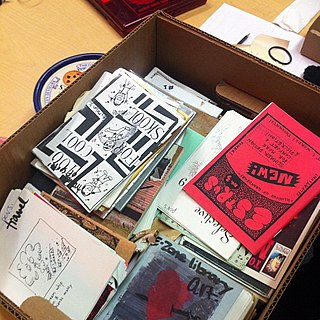 W
WA zine is a small-circulation self-published work of original or appropriated texts and images, usually reproduced via a copy machine. Zines are the product of either a single person or of a very small group, and are popularly photocopied into physical prints for circulation. A fanzine is a non-professional and non-official publication produced by enthusiasts of a particular cultural phenomenon for the pleasure of others who share their interest. The term was coined in an October 1940 science fiction fanzine by Russ Chauvenet and popularized within science fiction fandom, entering the Oxford English Dictionary in 1949.